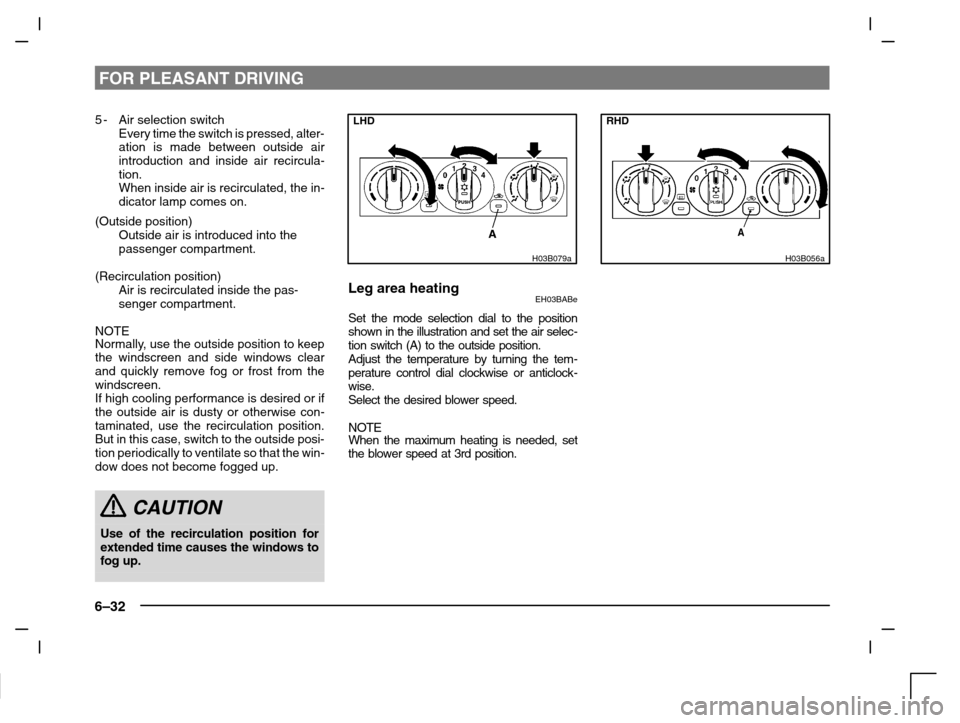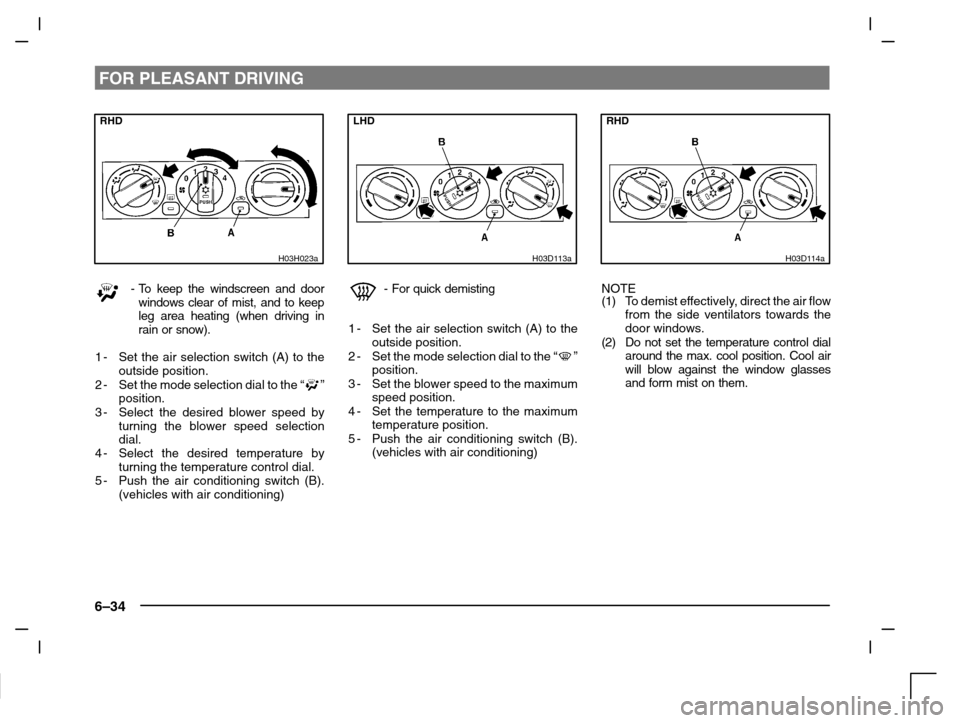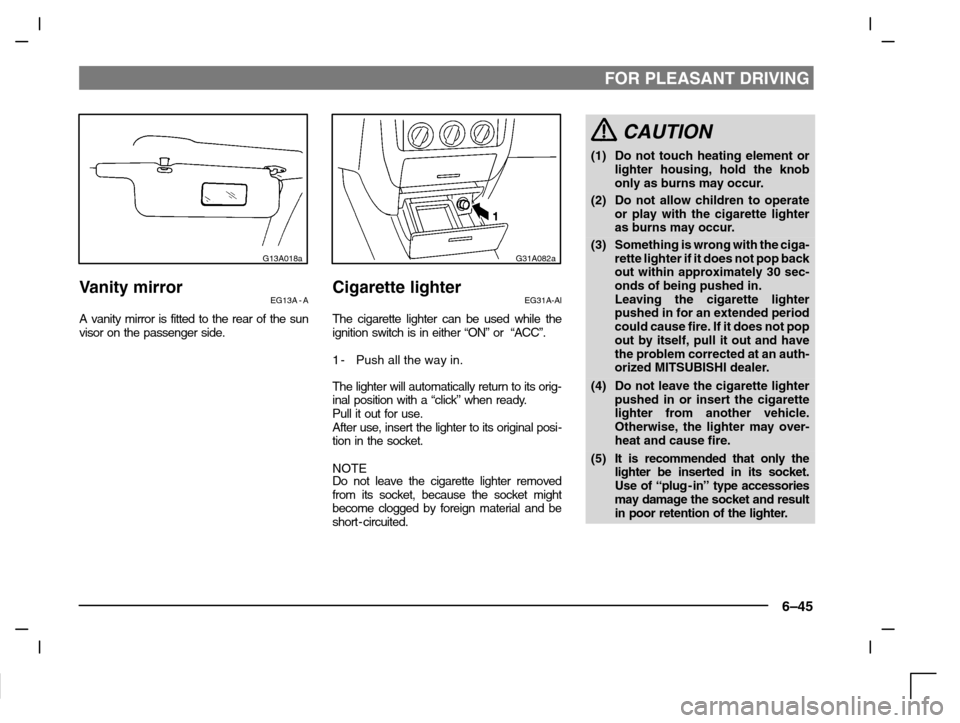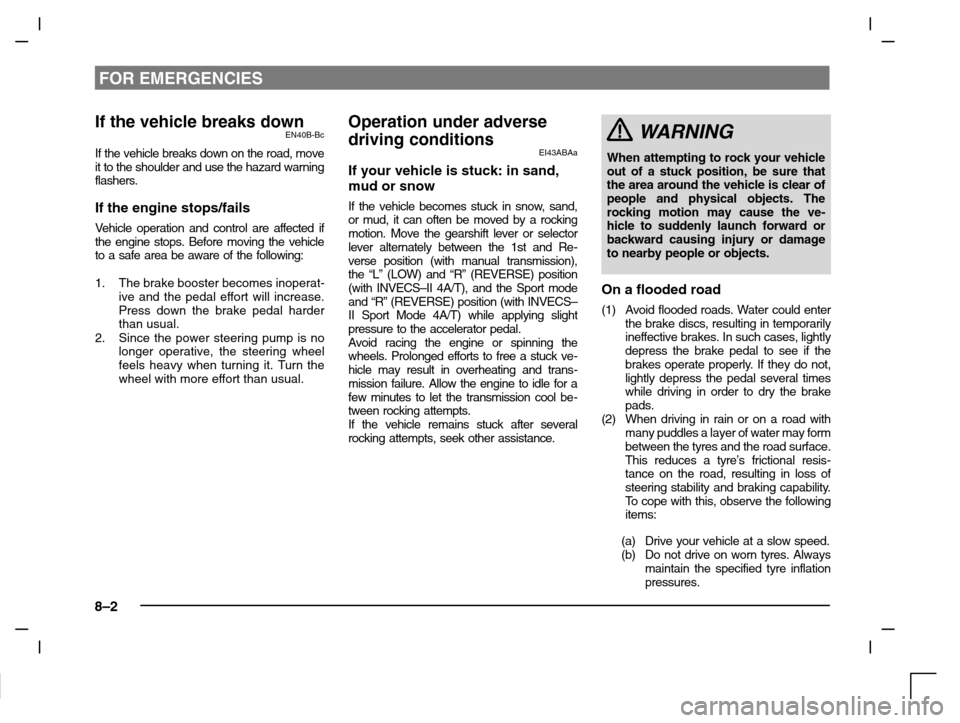2000 MITSUBISHI CARISMA heating
[x] Cancel search: heatingPage 172 of 280

FOR PLEASANT DRIVING
6–32
5-Air selection switch
Every time the switch is pressed, alter-
ation is made between outside air
introduction and inside air recircula-
tion.
When inside air is recirculated, the in-
dicator lamp comes on.
(Outside position)
Outside air is introduced into the
passenger compartment.
(Recirculation position)
Air is recirculated inside the pas-
senger compartment.
NOTE
Normally, use the outside position to keep
the windscreen and side windows clear
and quickly remove fog or frost from the
windscreen.
If high cooling performance is desired or if
the outside air is dusty or otherwise con-
taminated, use the recirculation position.
But in this case, switch to the outside posi-
tion periodically to ventilate so that the win-
dow does not become fogged up.
CAUTION
Use of the recirculation position for
extended time causes the windows to
fog up.
LHD
H03B079a
Leg area heatingEH03BABe
Set the mode selection dial to the position
shown in the illustration and set the air selec-
tion switch (A) to the outside position.
Adjust the temperature by turning the tem-
perature control dial clockwise or anticlock-
wise.
Select the desired blower speed.
NOTEWhen the maximum heating is needed, set
the blower speed at 3rd position.
RHD
H03B056a
Page 174 of 280

FOR PLEASANT DRIVING
6–34
RHD
H03H023a
-To keep the windscreen and door
windows clear of mist, and to keep
leg area heating (when driving in
rain or snow).
1-Set the air selection switch (A) to the
outside position.
2-Set the mode selection dial to the “
”
position.
3-Select the desired blower speed by
turning the blower speed selection
dial.
4-Select the desired temperature by
turning the temperature control dial.
5-Push the air conditioning switch (B).
(vehicles with air conditioning)
LHD
H03D113a
-For quick demisting
1-Set the air selection switch (A) to the
outside position.
2-Set the mode selection dial to the “
”
position.
3-Set the blower speed to the maximum
speed position.
4-Set the temperature to the maximum
temperature position.
5-Push the air conditioning switch (B).
(vehicles with air conditioning)
RHD
H03D114a
NOTE
(1)To demist effectively, direct the air flow
from the side ventilators towards the
door windows.
(2) Do not set the temperature control dial
around the max. cool position. Cool air
will blow against the window glasses
and form mist on them.
Page 181 of 280

FOR PLEASANT DRIVING
6–41
H14C081a
Blower speed indicator (A) is displayed in the
multi centre display.
Demisting of the windscreen and
door windows
EH03DAVa
CAUTION
For safety, make sure you have a clear
view through all windows.
To remove frost or mist from the windscreen
and door windows, use the mode selection
dial (“
” or “”).
H03D173a
-To keep the windscreen and door
windows clear of mist, and to keep
leg area heating (when driving in
rain or snow).
1-Set the air selection switch (A) to the
outside position.
2-Set the mode selection dial to the “
”
position.
3-Select the desired blower speed by
turning the blower speed selection
dial.
4-Select the desired temperature by
turning the temperature control dial.
5-Push the air conditioning switch (B).
Page 185 of 280

FOR PLEASANT DRIVING
6–45
G13A018a
Vanity mirrorEG13A - A
A vanity mirror is fitted to the rear of the sun
visor on the passenger side.
G31A082a
Cigarette lighterEG31A-Al
The cigarette lighter can be used while the
ignition switch is in either “ON” or “ACC”.
1-Push all the way in.
The lighter will automatically return to its orig-
inal position with a “click” when ready.
Pull it out for use.
After use, insert the lighter to its original posi-
tion in the socket.
NOTE
Do not leave the cigarette lighter removed
from its socket, because the socket might
become clogged by foreign material and be
short - circuited.
CAUTION
(1) Do not touch heating element or
lighter housing, hold the knob
only as burns may occur.
(2) Do not allow children to operate
or play with the cigarette lighter
as burns may occur.
(3) Something is wrong with the ciga-
rette lighter if it does not pop back
out within approximately 30 sec-
onds of being pushed in.
Leaving the cigarette lighter
pushed in for an extended period
could cause fire. If it does not pop
out by itself, pull it out and have
the problem corrected at an auth-
orized MITSUBISHI dealer.
(4) Do not leave the cigarette lighter
pushed in or insert the cigarette
lighter from another vehicle.
Otherwise, the lighter may over-
heat and cause fire.
(5) It is recommended that only the
lighter be inserted in its socket.
Use of “plug - in” type accessories
may damage the socket and result
in poor retention of the lighter.
Page 201 of 280

For emergencies
If the vehicle breaks down 8–2. . . . . . . . . . . . . . . . .
Operation under adverse driving conditions 8–2. .
Tools and jack 8–3. . . . . . . . . . . . . . . . . . . . . . . . . . . .
Jacking up the vehicle 8–4. . . . . . . . . . . . . . . . . . . . .
Spare wheel 8–6. . . . . . . . . . . . . . . . . . . . . . . . . . . . . .
Wheel covers* 8–8. . . . . . . . . . . . . . . . . . . . . . . . . . . .
If a tyre is punctured 8–9. . . . . . . . . . . . . . . . . . . . . .
Towing 8–12. . . . . . . . . . . . . . . . . . . . . . . . . . . . . . . . . .
Engine overheating 8–15. . . . . . . . . . . . . . . . . . . . . . .
Emergency starting 8–17. . . . . . . . . . . . . . . . . . . . . .
Bleeding the fuel system
(diesel-powered vehicles only) 8–21. . . . . . . . . . . . .
Removal of water from the fuel filter
(diesel-powered vehicles only) 8–21. . . . . . . . . . . . .
What to do if the engine speed becomes
unstable after the battery is replaced: 8–22. . . . . .
Fuses 8–22. . . . . . . . . . . . . . . . . . . . . . . . . . . . . . . . . . .
Changing a fuse 8–25. . . . . . . . . . . . . . . . . . . . . . . . .
Replacement of lamp bulbs 8–26. . . . . . . . . . . . . . .
Page 202 of 280

FOR EMERGENCIES
8–2
If the vehicle breaks downEN40B-Bc
If the vehicle breaks down on the road, move
it to the shoulder and use the hazard warning
flashers.
If the engine stops/fails
Vehicle operation and control are affected if
the engine stops. Before moving the vehicle
to a safe area be aware of the following:
1. The brake booster becomes inoperat-
ive and the pedal effort will increase.
Press down the brake pedal harder
than usual.
2. Since the power steering pump is no
longer operative, the steering wheel
feels heavy when turning it. Turn the
wheel with more effort than usual.
Operation under adverse
driving conditions
EI43ABAa
If your vehicle is stuck: in sand,
mud or snow
If the vehicle becomes stuck in snow, sand,
or mud, it can often be moved by a rocking
motion. Move the gearshift lever or selector
lever alternately between the 1st and Re-
verse position (with manual transmission),
the “L” (LOW) and “R” (REVERSE) position
(with INVECS–II 4A/T), and the Sport mode
and “R” (REVERSE) position (with INVECS–
II Sport Mode 4A/T) while applying slight
pressure to the accelerator pedal.
Avoid racing the engine or spinning the
wheels. Prolonged efforts to free a stuck ve-
hicle may result in overheating and trans-
mission failure. Allow the engine to idle for a
few minutes to let the transmission cool be-
tween rocking attempts.
If the vehicle remains stuck after several
rocking attempts, seek other assistance.
WARNING
When attempting to rock your vehicle
out of a stuck position, be sure that
the area around the vehicle is clear of
people and physical objects. The
rocking motion may cause the ve-
hicle to suddenly launch forward or
backward causing injury or damage
to nearby people or objects.
On a flooded road
(1) Avoid flooded roads. Water could enter
the brake discs, resulting in temporarily
ineffective brakes. In such cases, lightly
depress the brake pedal to see if the
brakes operate properly. If they do not,
lightly depress the pedal several times
while driving in order to dry the brake
pads.
(2) When driving in rain or on a road with
many puddles a layer of water may form
between the tyres and the road surface.
This reduces a tyre’s frictional resis-
tance on the road, resulting in loss of
steering stability and braking capability.
To cope with this, observe the following
items:
(a) Drive your vehicle at a slow speed.
(b) Do not drive on worn tyres. Always
maintain the specified tyre inflation
pressures.
Page 215 of 280

FOR EMERGENCIES
8–15
Towing the vehicle by a tow truck
CAUTION
(1) This vehicle cannot be towed by
a tow truck using Type A equip-
ment to prevent the bumper from
deformation. If this vehicle is
towed, use Type B, Type C, Type
D or Type E equipment.
(2) In case the vehicle with automatic
transmission must be towed far-
ther than 30 km, transport the ve-
hicle with all wheels off the
ground (Type B or C) or with front
wheels off the ground (Type D).
(3) If the transmission is not operat-
ing, transport the vehicle with all
wheels off the ground (Type B or
C).
Towing with front wheels off the
ground (Type D)
Release the parking brake. Place the gear-
shift lever (manual transmission) or the se-
lector lever (automatic transmission) in the
“N” (NEUTRAL) position.
Towing with rear wheels off the
ground (Type E)
Place the gearshift lever (manual trans-
mission) or the selector lever (automatic
transmission) in the “N” (NEUTRAL) posi-
tion.
Turn the ignition key to the “ACC” position
and secure the steering wheel in a straight-
ahead position with a rope, etc.
Never place the ignition key in the “LOCK”
position. It is dangerous as the steering
wheel may lock.
Engine overheatingEN26A - Ub
If the water temperature gauge indication re-
mains in the overheating zone for a long
time, the engine may be overheating. If this
occurs, take the following corrective
measures :
1. Stop the vehicle in a safe place.
Page 257 of 280

MAINTENANCE
9–19
L05A002a
3. Attach retainers (C) to a new wiper
blade.
4. Insert the wiper blade into the arm,
starting with the opposite end of the
blade from the stopper. Make sure the
hook (B) is fitted correctly in the
grooves in the blade.
NOTE
If retainers (C) are not supplied with the
new wiper blade, use the retainers from the
old blade.
L05A003a
5. Push the wiper blade until the hook (B)
engages securely with the stopper
(A).
Ventilation slotsEL06A-A
The ventilation slots in front of the wind-
screen should be brushed clear after a
heavy snowfall so that the operation of the
heating and ventilation systems will not be
impaired.
WeatherstrippingEL10A-Aa
To prevent freezing of the weatherstripping
on the doors, bonnet, etc., they should be
treated with silicone grease.
Additional equipment
(For regions where snow is
encountered)
EL14A-Ac
It is a good idea to carry a shovel or a
short - handled spade in the vehicle during
the winter so that you can clear away snow
if you get stranded. A small hand - brush for
sweeping snow off the vehicle and a plastic
scraper for the windscreen, side and rear
window are also useful.